Optimization of the Melting Performance of a Thermal Energy Storage Unit with Fractal Net Fins
Abstract
:1. Introduction
2. Melting in the Thermal Energy Storage Unit with Fractal Net Fins
2.1. Fractal Net Configuration
2.2. Theoretical Model
2.3. Model Verification
3. Results and Discussion
3.1. Melting Behaviors of the Thermal Energy Storage Unit
3.2. Optimal Fractal Net Fin Configuration: Effect of Length Ratio RL and Width Ratio RW
3.3. Dynamic Temperature Response
3.4. Effect of Initial Temperature Difference
4. Conclusions
- (1)
- The fractal net fins can significantly enhance the melting heat transfer performance of PCM in a thermal energy storage unit. The temperature distribution in the thermal energy storage unit is more uniform, and the temperature gradient of the PCM is reduced and the energy utilization rate is improved. It takes about 510 s for the thermal energy storage unit with fractal net fins to complete the melting phase change, while it takes 1130 s for the thermal energy storage unit with ordinary fins.
- (2)
- The fin configuration in a thermal energy storage unit is optimal when the length and width ratios of fractal net are 0.5. The average temperature of a thermal energy storage unit with a large length ratio increases more significantly. A larger width ratio of the fractal net fin results in the faster temperature variation, and the heat transfer performance of the thermal energy storage unit decreases with the increase of the width ratio. In addition, the heat transfer at the corner points of the thermal energy storage unit is better than that at the central points no matter what the fin configuration.
- (3)
- The initial temperature difference is an important factor affecting the melting performance. A larger initial temperature difference leads to a large heat flux of PCM and shortens the duration time in a thermal energy storage unit no matter what fin configuration is used. When the initial temperature difference is the same, the duration time of PCM in a thermal energy storage unit with ordinary fins is more than twice as long as that with fractal net fins.
Author Contributions
Funding
Conflicts of Interest
References
- Liu, X.; Chen, Y.; Shi, M. Dynamic performance analysis on start-up of closed-loop pulsating heat pipes (clphps). Int. J. Therm. Sci. 2013, 65, 224–233. [Google Scholar] [CrossRef]
- Zhang, C.; Shen, C.; Chen, Y. Experimental study on flow condensation of mixture in a hydrophobic microchannel. Int. J. Heat Mass Transf. 2017, 104, 1135–1144. [Google Scholar] [CrossRef]
- Miró, L.; Gasia, J.; Cabeza, L.F. Thermal energy storage (tes) for industrial waste heat (iwh) recovery: A review. Appl. Energy 2016, 179, 284–301. [Google Scholar] [CrossRef]
- Chen, Y.; Gao, W.; Zhang, C.; Zhao, Y. Three-dimensional splitting microfluidics. Lab Chip 2016, 16, 1332–1339. [Google Scholar] [CrossRef] [PubMed]
- Wang, J.; Sun, L.; Zou, M.; Gao, W.; Liu, C.; Shang, L.; Gu, Z.; Zhao, Y. Bioinspired shape-memory graphene film with tunable wettability. Sci. Adv. 2017, 3, e1700004. [Google Scholar] [CrossRef]
- Wang, J.; Gao, W.; Zhang, H.; Zou, M.H.; Chen, Y.P.; Zhao, Y.J. Programmable wettability on photocontrolled graphene film. Sci. Adv. 2018, 4, eaat7392. [Google Scholar] [CrossRef]
- Zheng, Z.-J.; Xu, Y.; Li, M.-J. Eccentricity optimization of a horizontal shell-and-tube latent-heat thermal energy storage unit based on melting and melting-solidifying performance. Appl. Energy 2018, 220, 447–454. [Google Scholar] [CrossRef]
- Xiong, T.; Wang, Y.; Yang, X. Numerical investigation of dynamic melting process in a thermal energy storage system using u-tube heat exchanger. Adv. Mech. Eng. 2017, 9. [Google Scholar] [CrossRef]
- Mahdi, J.M.; Lohrasbi, S.; Ganji, D.D.; Nsofor, E.C. Accelerated melting of pcm in energy storage systems via novel configuration of fins in the triplex-tube heat exchanger. Int. J. Heat Mass Transf. 2018, 124, 663–676. [Google Scholar] [CrossRef]
- Amagour, M.E.H.; Rachek, A.; Bennajah, M.; Ebn Touhami, M. Experimental investigation and comparative performance analysis of a compact finned-tube heat exchanger uniformly filled with a phase change material for thermal energy storage. Energ. Convers. Manag. 2018, 165, 137–151. [Google Scholar] [CrossRef]
- Zheng, X.; Xie, N.; Chen, C.; Gao, X.; Huang, Z.; Zhang, Z. Numerical investigation on paraffin/expanded graphite composite phase change material based latent thermal energy storage system with double spiral coil tube. Appl. Therm. Eng. 2018, 137, 164–172. [Google Scholar] [CrossRef]
- Liu, X.; Rao, Z. Experimental study on the thermal performance of graphene and exfoliated graphite sheet for thermal energy storage phase change material. Thermochim. Acta 2017, 647, 15–21. [Google Scholar] [CrossRef]
- Das, N.; Kohno, M.; Takata, Y.; Patil, D.V.; Harish, S. Enhanced melting behavior of carbon based phase change nanocomposites in horizontally oriented latent heat thermal energy storage system. Appl. Therm. Eng. 2017, 125, 880–890. [Google Scholar] [CrossRef]
- Ebadi, S.; Tasnim, S.H.; Aliabadi, A.A.; Mahmud, S. Melting of nano-pcm inside a cylindrical thermal energy storage system: Numerical study with experimental verification. Energ. Convers. Manag. 2018, 166, 241–259. [Google Scholar] [CrossRef]
- Jannesari, H.; Abdollahi, N. Experimental and numerical study of thin ring and annular fin effects on improving the ice formation in ice-on-coil thermal storage systems. Appl. Energy 2017, 189, 369–384. [Google Scholar] [CrossRef]
- Augspurger, M.; Choi, K.K.; Udaykumar, H.S. Optimizing fin design for a pcm-based thermal storage device using dynamic kriging. Int. J. Heat Mass Transf. 2018, 121, 290–308. [Google Scholar] [CrossRef]
- Deng, Z.; Liu, X.; Zhang, C.; Huang, Y.; Chen, Y. Melting behaviors of pcm in porous metal foam characterized by fractal geometry. Int. J. Heat Mass Transf. 2017, 113, 1031–1042. [Google Scholar] [CrossRef]
- Zhang, C.; Wu, L.; Chen, Y. Study on solidification of phase change material in fractal porous metal foam. Fractals 2015, 23, 1540003. [Google Scholar] [CrossRef]
- Yang, X.; Feng, S.; Zhang, Q.; Chai, Y.; Jin, L.; Lu, T.J. The role of porous metal foam on the unidirectional solidification of saturating fluid for cold storage. Appl. Energy 2017, 194, 508–521. [Google Scholar] [CrossRef]
- Jourabian, M.; Farhadi, M.; Rabienataj Darzi, A. Constrained ice melting around one cylinder in horizontal cavity accelerated using three heat transfer enhancement techniques. Int. J. Therm. Sci. 2018, 125, 231–247. [Google Scholar] [CrossRef]
- Mahdi, J.M.; Nsofor, E.C. Melting enhancement in triplex-tube latent thermal energy storage system using nanoparticles-fins combination. Int. J. Heat Mass Transf. 2017, 109, 417–427. [Google Scholar] [CrossRef]
- Zhang, C.; Chen, Y.; Shi, M. Effects of roughness elements on laminar flow and heat transfer in microchannels. Chem. Eng. Process. 2010, 49, 1188–1192. [Google Scholar] [CrossRef]
- Zhang, C.; Chen, Y.; Deng, Z.; Shi, M. Role of rough surface topography on gas slip flow in microchannels. Phys. Rev. E 2012, 86, 016319. [Google Scholar] [CrossRef] [PubMed]
- Huang, Z.; Hwang, Y.; Radermacher, R. Review of nature-inspired heat exchanger technology. Int. J. Refrig. 2017, 78, 1–17. [Google Scholar] [CrossRef]
- Chen, Y.; Zhang, C.; Shi, M.; Yang, Y. Thermal and hydrodynamic characteristics of constructal tree-shaped minichannel heat sink. AIChE J. 2010, 56, 2018–2029. [Google Scholar] [CrossRef]
- Bejan, A. Shape and Structure, from Engineering to Nature; Cambridge University Press: Cambridge, UK, 2000. [Google Scholar]
- Tarasov, V.E. Heat transfer in fractal materials. Int. J. Heat Mass Transf. 2016, 93, 427–430. [Google Scholar] [CrossRef]
- Chen, Y.; Zhang, C.; Wu, R.; Shi, M. Methanol steam reforming in microreactor with constructal tree-shaped network. J. Power Sources 2011, 196, 6366–6373. [Google Scholar] [CrossRef]
- Zhang, C.; Chen, Y.; Wu, R.; Shi, M. Flow boiling in constructal tree-shaped minichannel network. Int. J. Heat Mass Transf. 2011, 54, 202–209. [Google Scholar] [CrossRef]
- Chen, Y.; Cheng, P. An experimental investigation on the thermal efficiency of fractal tree-like microchannel nets. Int. Commun. Heat Mass Transf. 2005, 32, 931–938. [Google Scholar] [CrossRef]
- He, G.; Kochergin, V.; Li, Y.; Nandakumar, K. Investigations about the effect of fractal distributors on the hydrodynamics of fractal packs of novel plate and frame designs. Chem. Eng. Sci. 2018, 177, 195–209. [Google Scholar] [CrossRef]
- Chen, Y.P.; Deng, Z.L. Hydrodynamics of a droplet passing through a microfluidic t-junction. J. Fluid Mech. 2017, 819, 401–434. [Google Scholar] [CrossRef]
- Liu, X.; Zhang, C.; Yu, W.; Deng, Z.; Chen, Y. Bubble breakup in a microfluidic t-junction. Sci. Bull. 2016, 61, 811–824. [Google Scholar] [CrossRef]
- Zhang, C.B.; Deng, Z.L.; Chen, Y.P. Temperature jump at rough gas-solid interface in couette flow with a rough surface described by cantor fractal. Int. J. Heat Mass Transf. 2014, 70, 322–329. [Google Scholar] [CrossRef]
- Bejan, A. The Physics of Life: The Evolution of Everything; St. Martin’s Press: New York, NY, USA, 2016. [Google Scholar]
- Boeing, G. Visual analysis of nonlinear dynamical systems: Chaos, fractals, self-similarity and the limits of prediction. Systems 2016, 4, 37. [Google Scholar] [CrossRef]
- Tian, Y.; Zhao, C.Y. A numerical investigation of heat transfer in phase change materials (pcms) embedded in porous metals. Energy 2011, 36, 5539–5546. [Google Scholar] [CrossRef]
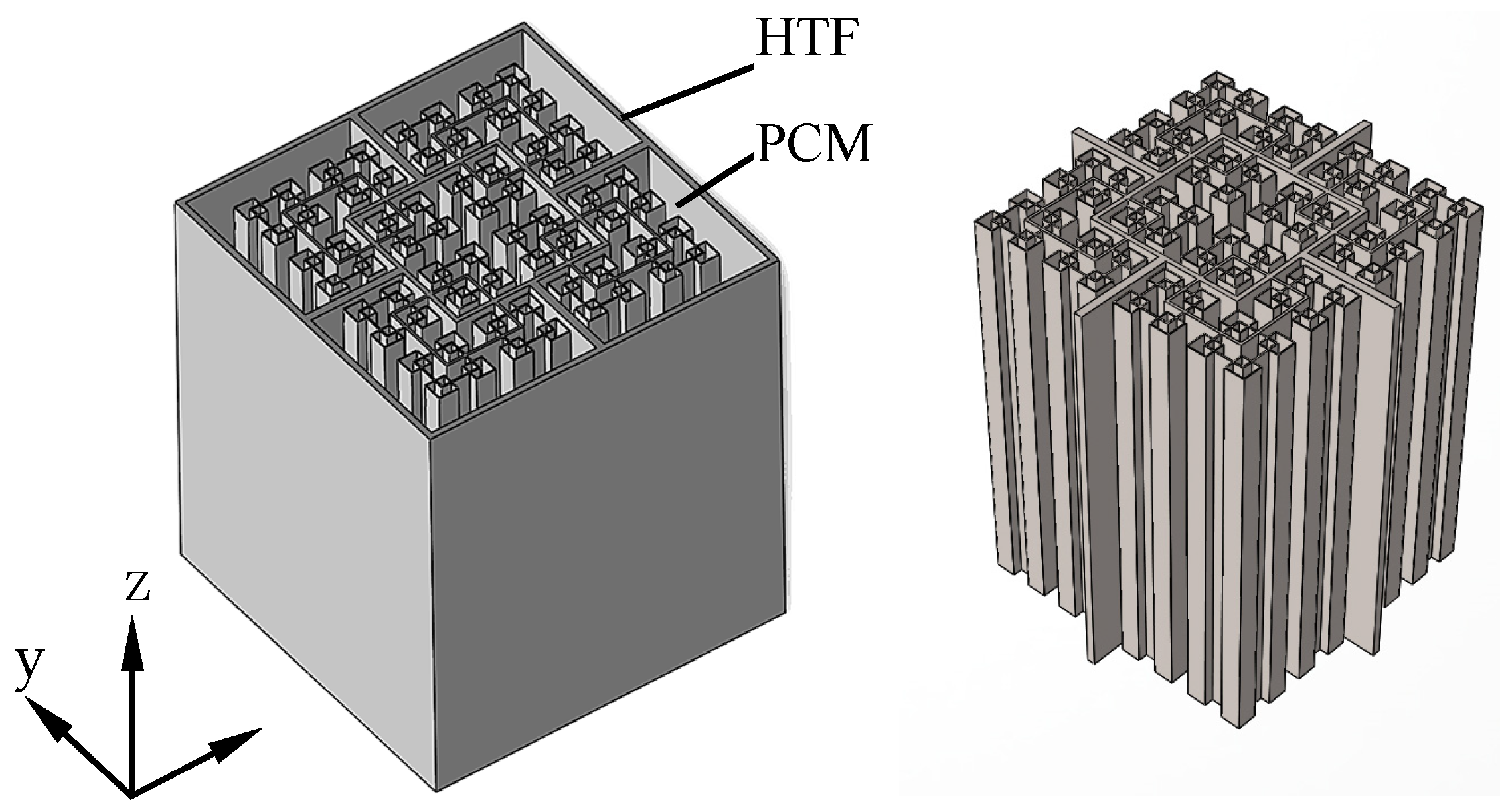
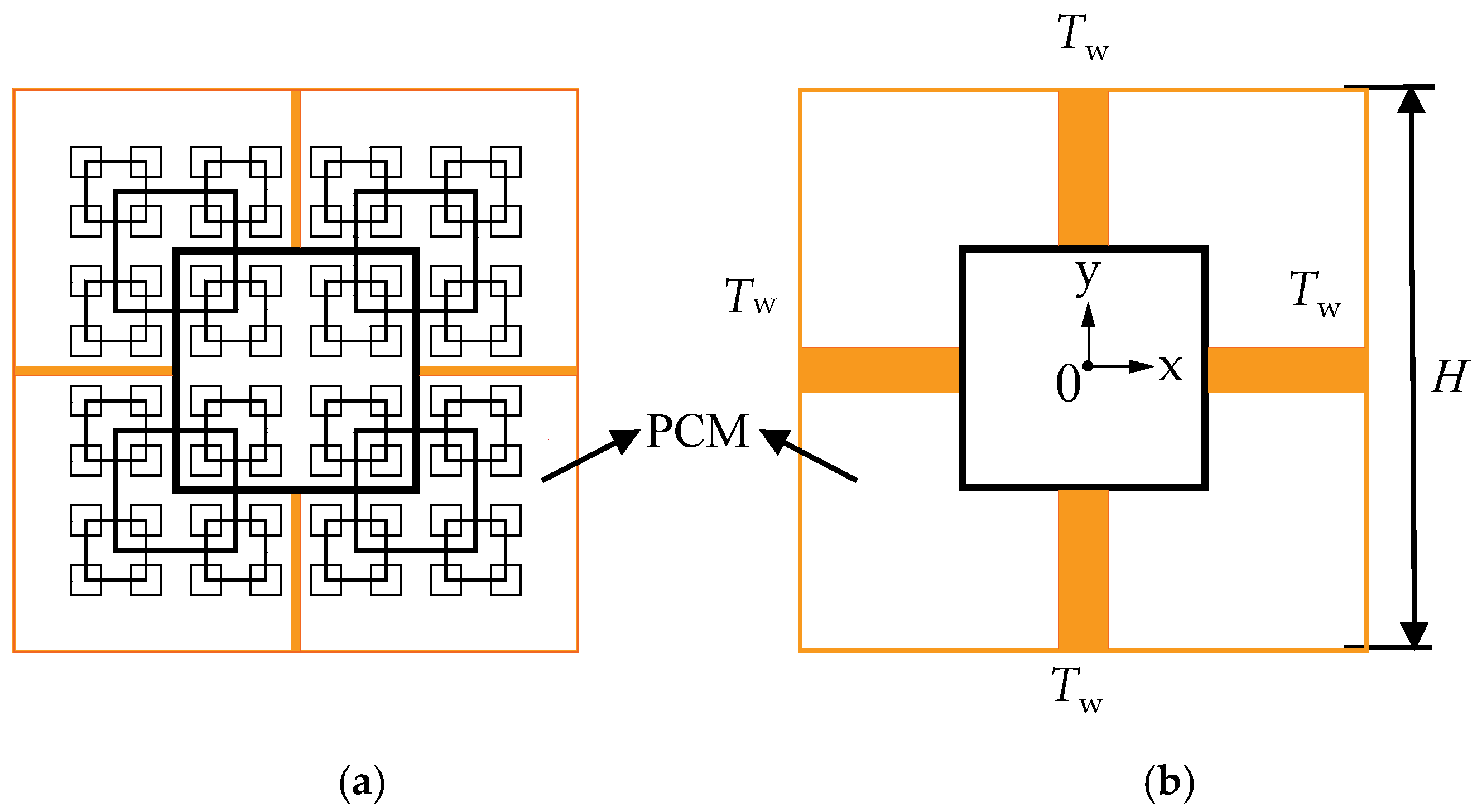

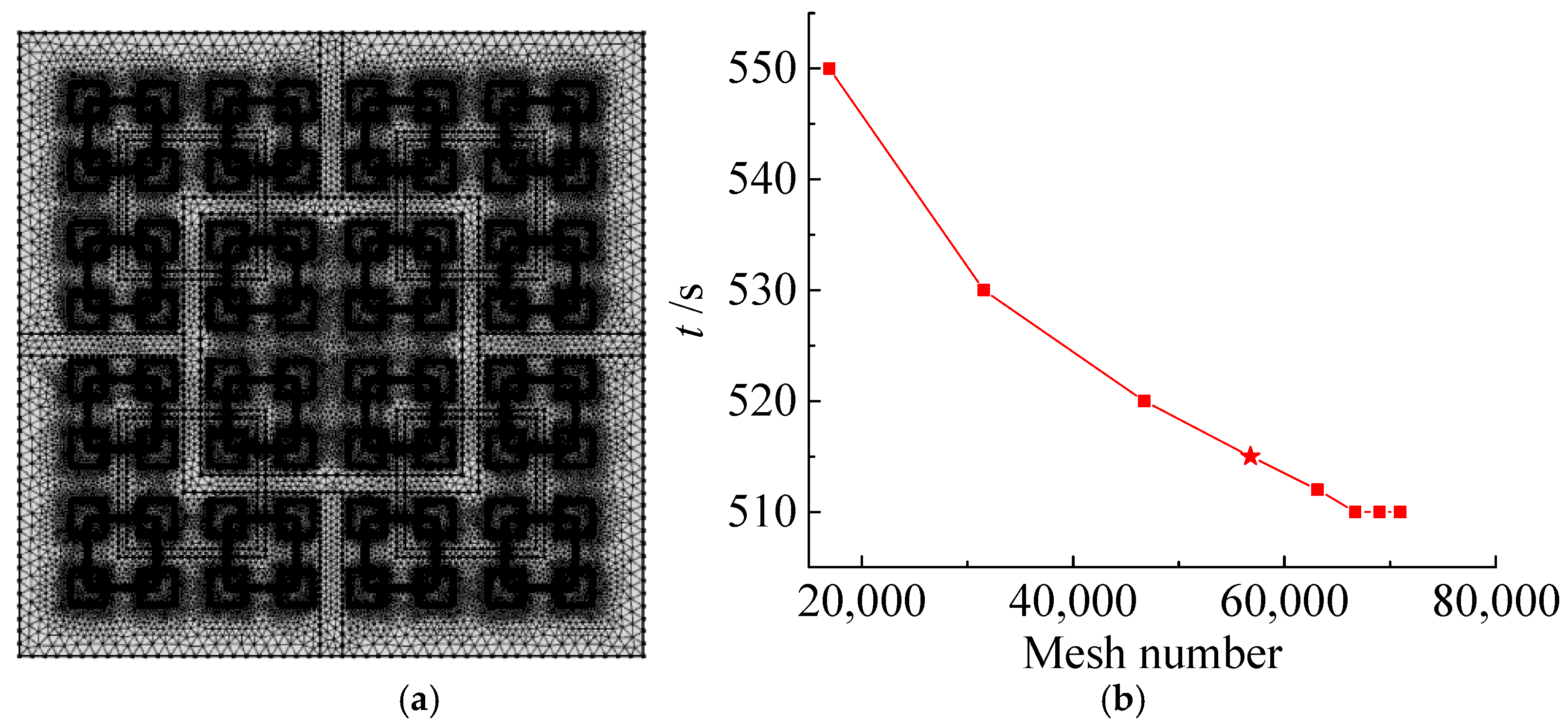
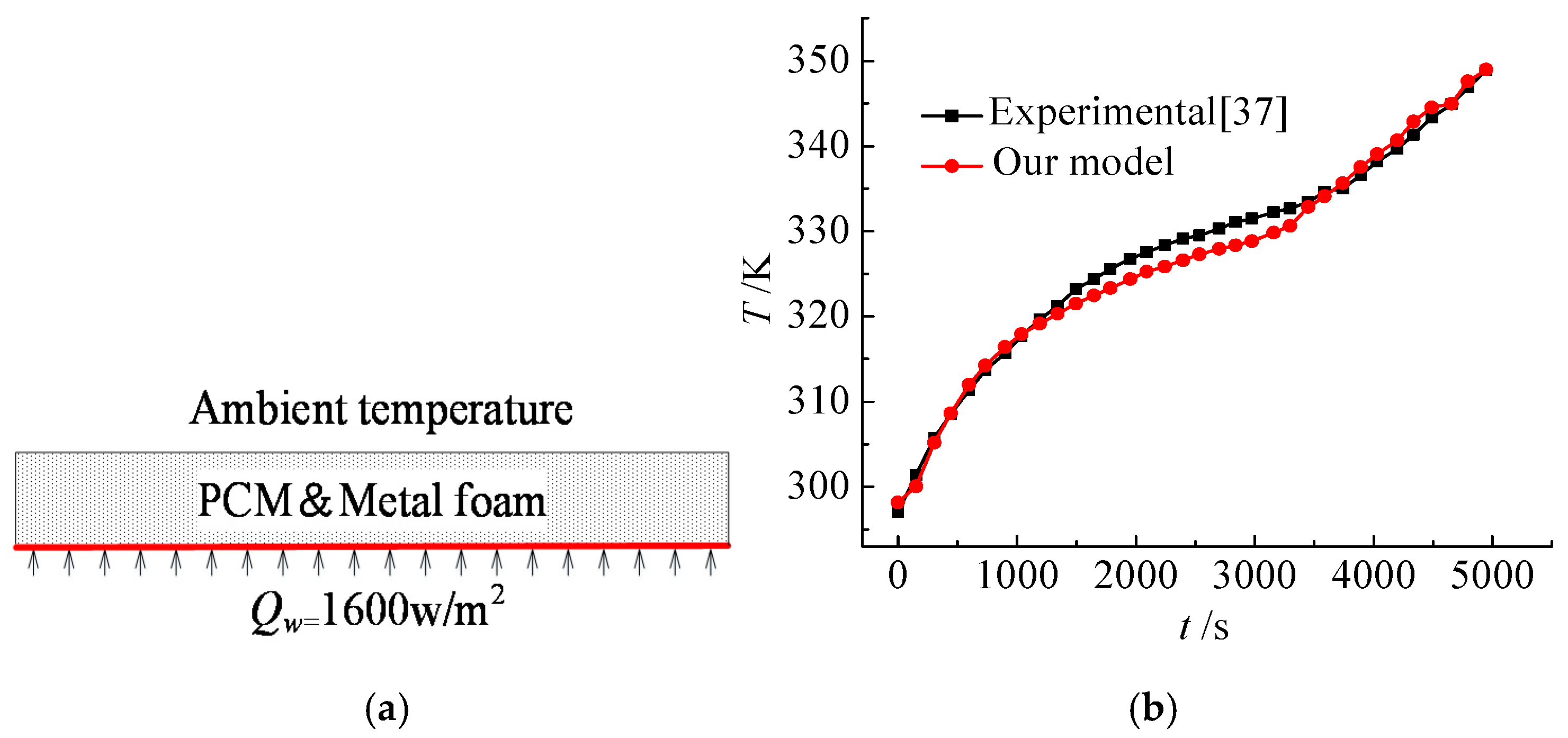

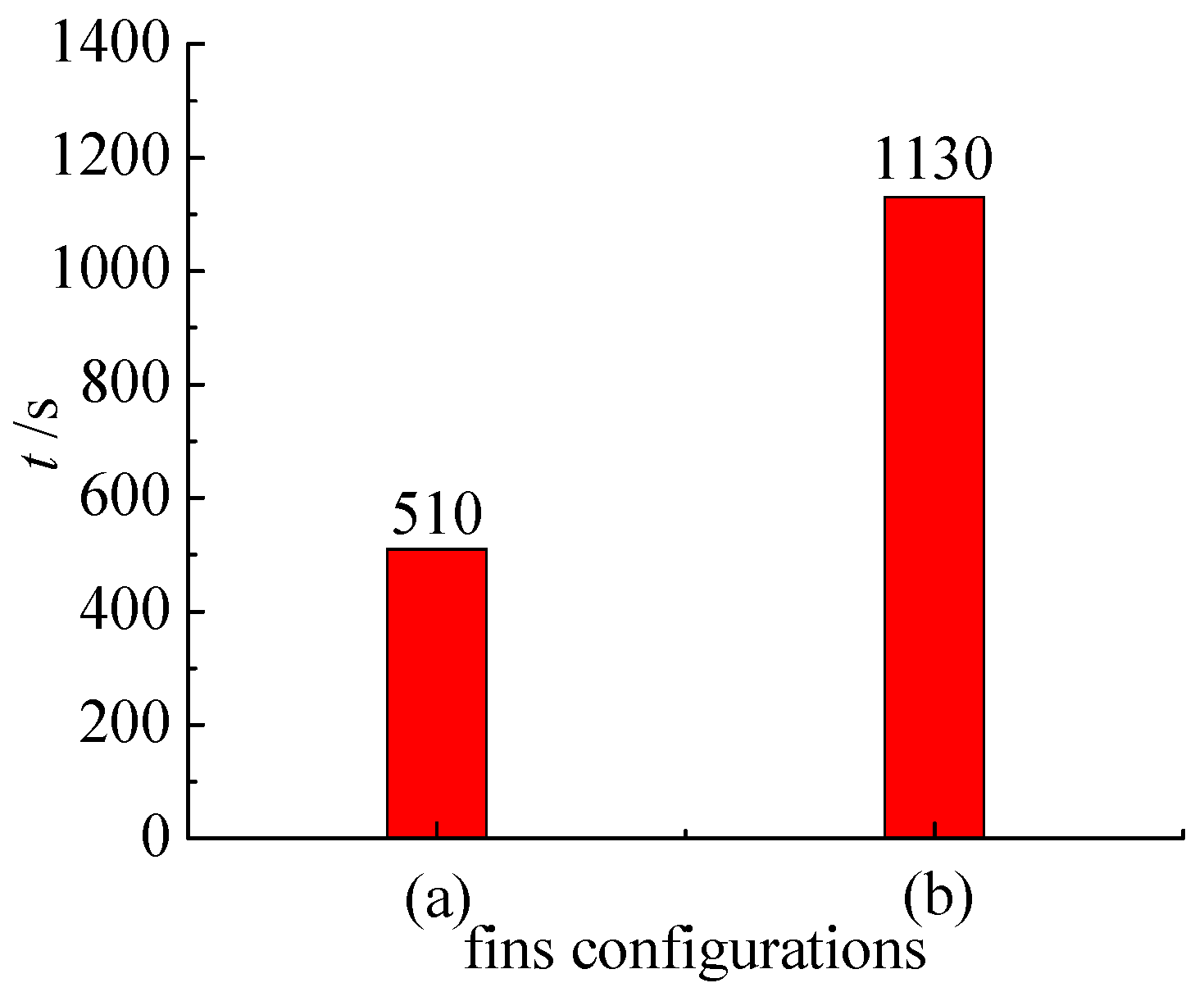
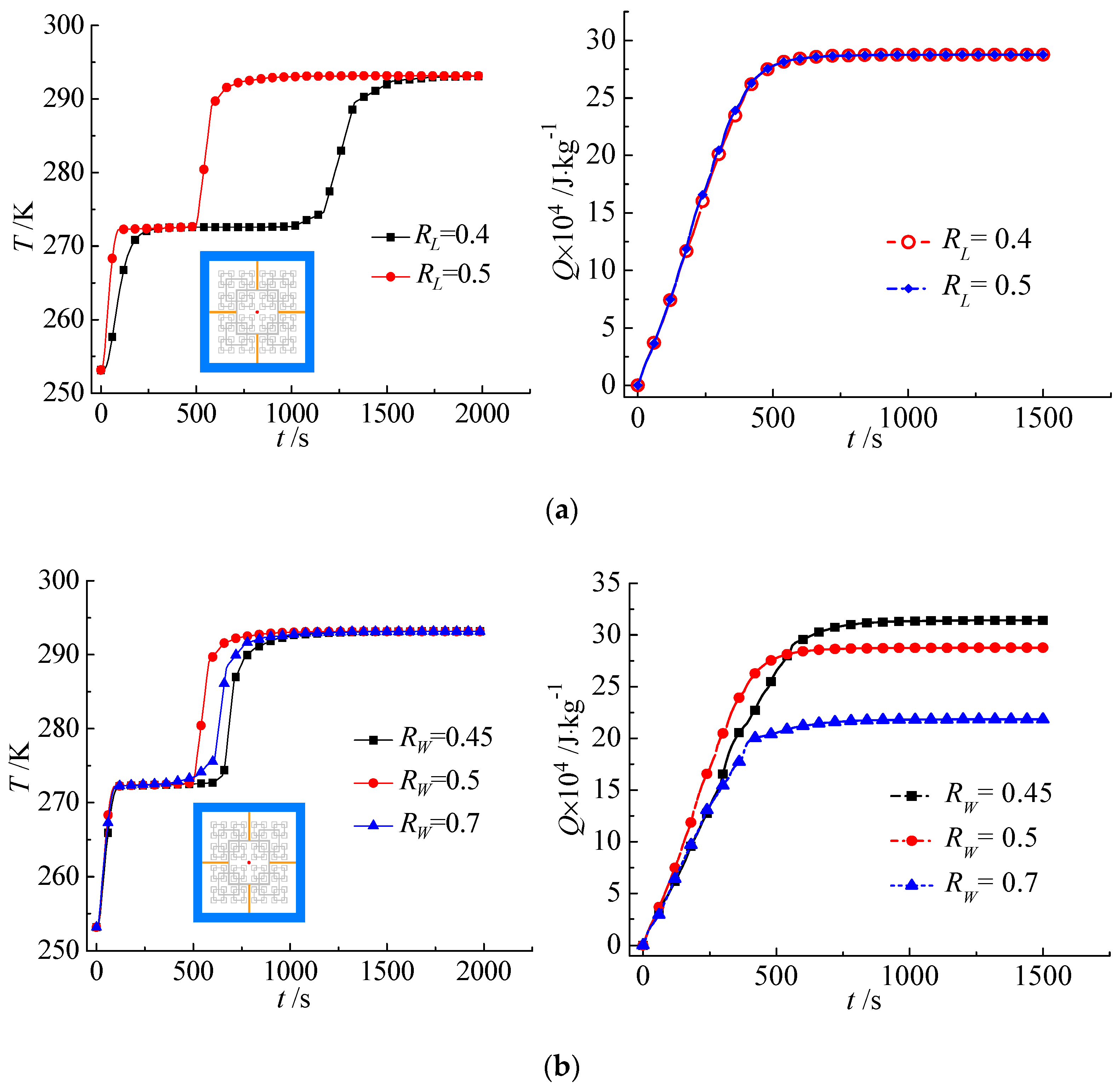
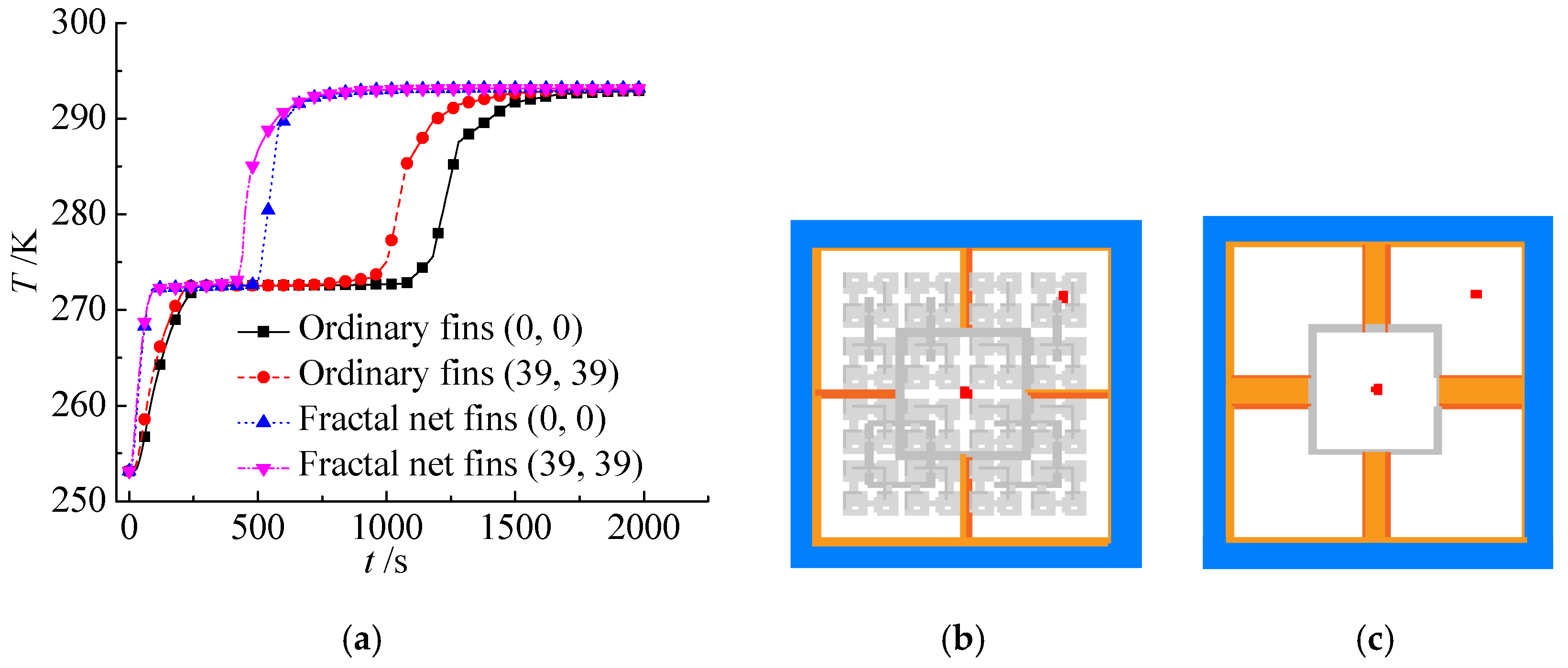

| Materials | λ/W·(m·K)−1 | cp/J·(kg·K)−1 | ρ/kg·m−3 | Lat/kJ·kg−1 | Tm/K |
|---|---|---|---|---|---|
| Copper | 400 | 385 | 8960 | — | — |
| Water (solid) | 2.22 | 2000 | 900 | 333 | 273.15 |
| Water (liquid) | 0.599 | 4184 | 1000 |
© 2019 by the authors. Licensee MDPI, Basel, Switzerland. This article is an open access article distributed under the terms and conditions of the Creative Commons Attribution (CC BY) license (http://creativecommons.org/licenses/by/4.0/).
Share and Cite
Zheng, J.; Yu, C.; Chen, T.; Yu, Y.; Wang, F. Optimization of the Melting Performance of a Thermal Energy Storage Unit with Fractal Net Fins. Processes 2019, 7, 42. https://doi.org/10.3390/pr7010042
Zheng J, Yu C, Chen T, Yu Y, Wang F. Optimization of the Melting Performance of a Thermal Energy Storage Unit with Fractal Net Fins. Processes. 2019; 7(1):42. https://doi.org/10.3390/pr7010042
Chicago/Turabian StyleZheng, Jiayi, Cheng Yu, Taotao Chen, Yanshun Yu, and Fang Wang. 2019. "Optimization of the Melting Performance of a Thermal Energy Storage Unit with Fractal Net Fins" Processes 7, no. 1: 42. https://doi.org/10.3390/pr7010042




